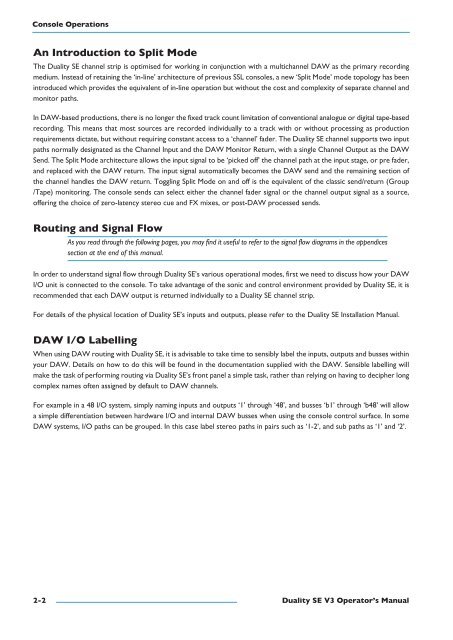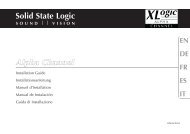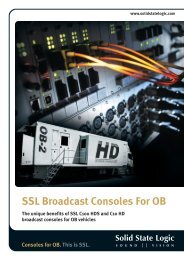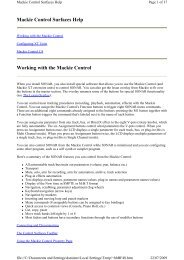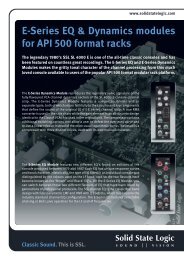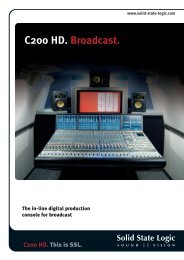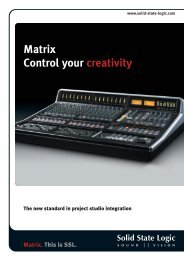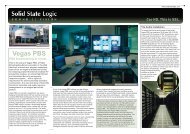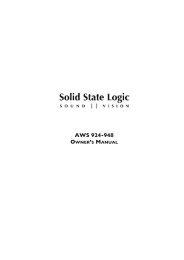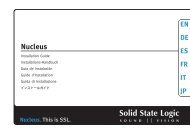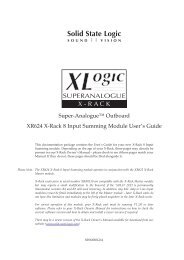Duality SE Operator's Manual - Solid State Logic
Duality SE Operator's Manual - Solid State Logic
Duality SE Operator's Manual - Solid State Logic
Create successful ePaper yourself
Turn your PDF publications into a flip-book with our unique Google optimized e-Paper software.
Console Operationsan Introduction to split ModeThe <strong>Duality</strong> <strong>SE</strong> channel strip is optimised for working in conjunction with a multichannel DAW as the primary recordingmedium. Instead of retaining the ‘in-line’ architecture of previous SSL consoles, a new ‘Split Mode’ mode topology has beenintroduced which provides the equivalent of in-line operation but without the cost and complexity of separate channel andmonitor paths.In DAW-based productions, there is no longer the fixed track count limitation of conventional analogue or digital tape-basedrecording. This means that most sources are recorded individually to a track with or without processing as productionrequirements dictate, but without requiring constant access to a ‘channel’ fader. The <strong>Duality</strong> <strong>SE</strong> channel supports two inputpaths normally designated as the Channel Input and the DAW Monitor Return, with a single Channel Output as the DAWSend. The Split Mode architecture allows the input signal to be ‘picked off’ the channel path at the input stage, or pre fader,and replaced with the DAW return. The input signal automatically becomes the DAW send and the remaining section ofthe channel handles the DAW return. Toggling Split Mode on and off is the equivalent of the classic send/return (Group/Tape) monitoring. The console sends can select either the channel fader signal or the channel output signal as a source,offering the choice of zero-latency stereo cue and FX mixes, or post-DAW processed sends.routing and signal FlowAs you read through the following pages, you may find it useful to refer to the signal flow diagrams in the appendicessection at the end of this manual.In order to understand signal flow through <strong>Duality</strong> <strong>SE</strong>’s various operational modes, first we need to discuss how your DAWI/O unit is connected to the console. To take advantage of the sonic and control environment provided by <strong>Duality</strong> <strong>SE</strong>, it isrecommended that each DAW output is returned individually to a <strong>Duality</strong> <strong>SE</strong> channel strip.For details of the physical location of <strong>Duality</strong> <strong>SE</strong>’s inputs and outputs, please refer to the <strong>Duality</strong> <strong>SE</strong> Installation <strong>Manual</strong>.Daw I/O labellingWhen using DAW routing with <strong>Duality</strong> <strong>SE</strong>, it is advisable to take time to sensibly label the inputs, outputs and busses withinyour DAW. Details on how to do this will be found in the documentation supplied with the DAW. Sensible labelling willmake the task of performing routing via <strong>Duality</strong> <strong>SE</strong>’s front panel a simple task, rather than relying on having to decipher longcomplex names often assigned by default to DAW channels.For example in a 48 I/O system, simply naming inputs and outputs ‘1’ through ‘48’, and busses ‘b1’ through ‘b48’ will allowa simple differentiation between hardware I/O and internal DAW busses when using the console control surface. In someDAW systems, I/O paths can be grouped. In this case label stereo paths in pairs such as ‘1-2’, and sub paths as ‘1’ and ‘2’.2-2 <strong>Duality</strong> se V3 Operator’s <strong>Manual</strong>


